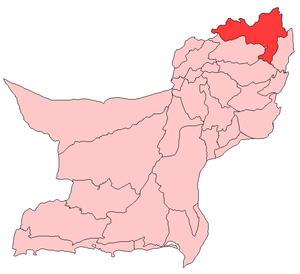Please tell us which country and city you'd like to see the weather in.

Zhob River
Zhob River (Pashto: ژوب سيند) is located in Balochistan and Khyber Pakhtunkhwa, Pakistan. The total length of the Zhob River is 410 km, and it flows on a generally northeasterly course. Linguistically the name is Irano-Aryan in origin and compares etymologically to those of the Little Zab and Great Zab rivers in the Tigris Basin. In the Pashto language, Zhob means "oozing water". The older name Yavyāvati of the Rigveda may refer to the Zhob River.
The Zhob River originates in the Kan Metarzai range (Tsari Mehtarazai Pass). It passes about 4 km west of the city of Zhob. As a tributary of the Gomal River, which it joins near Khajuri Kach, it forms a part of the Indus River Basin.
The Zhob River is used to irrigate the land in northern Balochistan along with the Gomal River, making the fertile soil available for agriculture. Although in the 1960s and 1970s degradation of the channel of the Zhob decreased the irrigable acreage.
References
Coordinates: 32°04′N 69°51′E / 32.067°N 69.850°E / 32.067; 69.850

Zhob
Zhob (Pashto: ژوب) is a small town and district capital of Zhob District in Balochistan province of Pakistan. Zhob is located on the banks of Zhob River. The city was originally named Appozai after a nearby village. During the British colonial area it was named Fort Sandeman. It obtained its current name on 30 July 1976 when the then Prime Minister of Pakistan, Zulfikar Ali Bhutto had the name changed.
History
A Chinese pilgrim, Xuanzang, who visited the region in 629 AD mentioned Pashtuns living in Zhob. He also pointed out Sardar Shams uddin as the bravest man ever known to him. Sardar Shams Uddin's companion Mohammad Siddiq is also known as (Takra Sarai) of the region. The prime historical importance of Zhob is having been a cradle of the Pashtuns. In the 7th century, Hiuen Tsiang, a Chinese pilgrim has described the Pashtuns as living in Zhob. Early in the 13th century the country came within the sphere of the barbaric Mongol raids organised by Genghis Khan. In 1398 AD, an expedition against the Pashtuns of the area was led by Pir Muhammad, grandson of Amir Timur. Although no authentic information exist about any foreign occupation, many forts, mounds and karezes are attributed to the Mughals. Both Nadir Shah (1736-47 AD) and Ahmed Shah Abdali (1747-73 AD) extended their power through Balochistan and thenceforth Zhob remained under the more or less nominal suzerainty of the Durranis and Barakzais until it came under British protection.

Zhob District
Zhob (Pashto: ژوب) is a district in the north west of Balochistan province of Pakistan. Zhob District is a Provincially Administered Tribal Area. It is subdivided into three subdistricts: Ashwat, Zhob, Qamar Din Karez and Sambaza. The population of Zhob District is estimated to be over 400,000 in 2011. Zhob River is used for irrigation in the Zhob District.
Administration
There are currently four tehsils in Zhob District. and Sherani New District
Population
The vast majority of the population of Zhob district is gurghasht. It is likely that over 99.7% of the people of the area are Muslims, with tiny numbers of Christians. Currently the tribes living in Zhob are given by; Mandokhail, Sherani, Kakar,], Harifal, Lawon, babar the local tribes while other immigrants include and make a huge population consisting of afghan pawandy like nasar kharoti safi ect. Currently a large number of IDPs have been settled within the confines of the Distt. NB: pleased to draw the attention of the Webmaster towards Zhob Tehsil and new announced boundary. Ist., there were only 2 tehsils, Zhob Tehsil and Tehsil Qamar din Karez Tehsil. While now Sherani Tehsil merged in Sherani District, it was announce as new district 3 years ago.
Radio Stations - Zhob_River
SEARCH FOR RADIOS
Podcasts:

